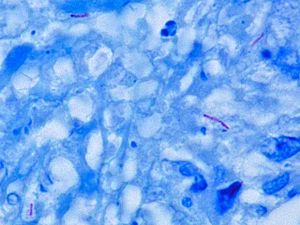A potential vaccine against tuberculosis has been found to completely eliminate tuberculosis bacteria from infected tissues in some mice.
The vaccine was created with a strain of bacteria that, due to the absence of a few genes, are unable to avoid its host’s first-line immune response. Once this first-line defense has been activated, it triggers the more specific immune response that can protect against future infections.
The research, by scientists at the Howard Hughes Medical Institute, Albert Einstein College of Medicine and Colorado State University, appears in the September 4, 2011, issue of Nature Medicine.
Tuberculosis, an infectious disease caused by Mycobacterium tuberculosis, is a global health concern, accounting for 2-3 million deaths annually. One third of the world’s population is infected with the bacterium, and according to the World Health Organization, new infections occur at a rate of about one per second. Most people who are infected don’t get sick, because the immune system keeps the bacteria under control. However, people whose immune systems are weakened, such as those with HIV/AIDS, are highly susceptible to the active form of the infection. With staggering rates of HIV infection in some parts of the world, such as Africa, co-infection with TB is a serious problem. To make matters worse, some strains of M. tuberculosis have become resistant to every drug currently used to treat tuberculosis.
“We’re back to where we were before there were drugs for TB,” says William R. Jacobs, Jr., an HHMI investigator at Albert Einstein College of Medicine.
The only vaccine in current use, called Bacille Calmette-Guérin (BCG), hasn’t been consistently effective at protecting against the disease, especially in regions with the largest numbers of cases. BCG is a weakened strain of the tuberculosis bacteria that triggers the production of protective antibodies in some people. Although Jacobs and others have tried tinkering with BCG to make it more effective, “we’ve only been able to slow down the growth of M. tuberculosis,” Jacobs says. “We haven’t been able to kill TB with a vaccine until now.”
In the first part of the work, Jacobs and colleagues investigated a set of genes called esx-3 that is found in all mycobacteria. Previous research had suggested that mycobacteria need esx-3 to protect themselves from their hosts’ innate immune systems, a first-line defense against pathogens that responds to invaders quickly, but non-specifically. Jacobs and his team wanted to see if deleting the genes would affect the bacterium’s virulence, but they couldn’t do this directly with M. tuberculosis, because the bug can’t live without that set of genes. Instead, the researchers deleted the genes from a closely related but usually benign bacteria, Mycobacterium smegmatis, which can tolerate the deletion. They then infected mice with the M. smegmatis bacteria. Although the dose they injected was high enough that M. smegmatis with intact esx-3 genes rapidly killed the mice, an equivalent dose of the modified bacteria caused no harm — apparently because the immune system was able to find and kill bacteria that lacked esx-3.
These findings suggested that esx-3 plays a key role in protecting M. smegmatis from innate immunity. A key feature of innate immunity is that unlike the second branch of the immune system, adaptive immunity, innate immunity does not confer lasting protection against subsequent infections by the same pathogen.
The research team dubbed their modified strain of M. smegmatis “IKE” for immune killing evasion. Next, they inserted esx-3 genes from M. tuberculosis into the IKE strain, creating a new strain of M. smegmatis they called IKEPLUS. They thought this maneuver would restore the bacterium’s ability to evade innate immune killing. To their surprise — and initial disappointment — that wasn’t what happened. The IKEPLUS strain was just as susceptible as IKE to the mouse immune response. In fact, IKEPLUS induced an unusually strong adaptive immune response known as Th1 immunity (named for the T helper cells that coordinate it).
As lead author Kari Ann Sweeney and Jacobs dejectedly pored over the data, they had a flash of insight. “We said, ‘Maybe we’re just looking at this the wrong way. Maybe what we’ve really done is made the ideal vaccine vector. We have M. smegmatis eliciting Th1 immunity, and now that we’ve put in a bag of TB antigens, these mice might be protected against TB,’ “says Jacobs.
To test that possibility, the researchers gave five IKEPLUS-immunized mice — and a control group of five unimmunized mice — massive, intravenous doses of M. tuberculosis. All five of the unimmunized mice were dead within five days; all the IKEPLUS-immunized mice were still alive 40 days later. Two of the IKEPLUS mice survived to 90 days, and one of those lived to 343 days after infection with M. tuberculosis. Jacobs’s group repeated the experiments with more mice and compared the effects of IKEPLUS immunization with those of BCG immunization.
“We consistently protected mice better with IKEPLUS than with BCG,” Jacobs says. What’s more, when the researchers analyzed tissues from IKEPLUS-immunized mice that survived more than 200 days after exposure to M. tuberculosis, they found that the bacteria had been completely eliminated from the animals’ livers.
Bookmark this page for “Tuberculosis” and check back regularly as these articles update on a very frequent basis. The view is set to “news”. Try clicking on “video” and “2” for more articles.








